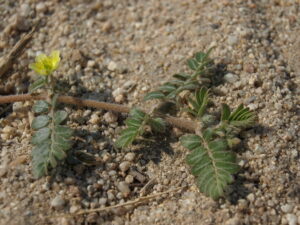 There’s no person, animal or surface that goatheads won’t prick. Whether in a field, the front yard or on the living room floor, the dreaded goathead finds a way to come out of nowhere to cause a temporary stinging sensation or annoyance.
There’s no person, animal or surface that goatheads won’t prick. Whether in a field, the front yard or on the living room floor, the dreaded goathead finds a way to come out of nowhere to cause a temporary stinging sensation or annoyance.
Goatheads, also known as puncture vines, are a non-native, noxious weed in Colorado and some other states. Plants get that designation when it’s determined they can be harmful to humans, livestock, agriculture and ecosystems. Goatheads are fitting examples, as their shape can easily puncture human skin, a pet’s paws or a bicycle’s tires.
In Pueblo, there’s no shortage of goatheads, which germinate annually. They cause gardeners to weed them out and force cyclists to swerve around them to avoid the need for tire repair. Sometimes they can be hard to spot, but you’ll know when one’s there because of the sudden sting it’ll cause.
“They’re summer annual and start forming once the weather starts to get warm and continue to grow,” said Sherie Shaffer, director for the Colorado State University Extension for Pueblo County. “They actually die in the winter and only spread by seed.”
But goatheads are not immortal or immune to removal. People in other Colorado cities have taken steps to get rid of them and avoid the aches and nuisances they cause.
Here’s what you should know about goatheads and what you can do about them.
How do goatheads form?
Tribulus terrestris is the formal name for the plant, which is native to Europe and part of the caltrop family. It does best in dry areas and in Colorado usually emerges throughout the summer, flowering between July and September. It typically spreads into a “mat-forming” cover that can span multiple feet and the seeds it produces usually have three spiny burs, according to the CSU Extension Office. Those burs resemble the head of a goat, hence the name, and are often really sharp, hence the pain.
“I find them more in less healthy lawns where there aren’t out-competing weeds,” Shaffer said. “That’s where you can almost look and say, ‘There’s probably some goatheads in that lawn so I need to wear my shoes.’ Or in areas that get kind of weedy, we definitely know that you have to watch out and wear your shoes.”
The plant goes through multiple phases before the goatheads are produced but can be identified by the bright yellow flower that appear during the flowering phase, according to Epic Gardening. It’s usually best to remove the plant at the early part of this phase, if not well before it, because the best way to control goatheads is to prevent them from producing seed.
“The more you can prevent them from going to seed, the better control you’re going to get over them,” Shaffer said.
Does the plant have any benefits?
There are some claims that tribulus terrestris can lessen angina, a type of chest pain, or boost testosterone levels. Others say it can enhance libido and help athletes perform better, among other advantages.
Shaffer said the CSU Extension office in Pueblo doesn’t have any research that indicates goatheads have health benefits to offer, but acknowledged that some indigenous groups might consider them useful in some ways.
How to get rid of goatheads in Pueblo
The plant can be hard to get rid of because of the four- to five-year lifespan its seeds have in soil, but there are some options to manage or try to remove it altogether.
One of those options is mechanical control, where a person uses their hands or shovel to remove the root. If removing them, remember to pull the plant sideways rather than upwards. It’s recommended to do this while the ground is moist and to bag the debris carefully so seeds don’t scatter. According to Waterwise Gardening, to ward off the plant’s return, place a few inches of mulch in the affected area to prevent the seeds from germinating.
Another solution is chemical control. A pre-emergent herbicide such as crabgrass preventer, when applied to the area infested with the plant, can control it as the seeds germinate. Pendimethalin or trifluralin are among the herbicidal ingredients people should look for and are particularly effective against puncturevine. However, if the plant has emerged from the soil, it’s best to use a post-emergent herbicide.
A third option is to use biological control such as Microlarinus lareynii, a seed feeding weevil, and Microlarinus lypriformis, a stem boring weevil. The Colorado Department of Agriculture considers these insects the most successful biological control agents as both, in their own ways, feed on the seeds and stems of the plant. They are available through the department’s Request-A-Bug program.


